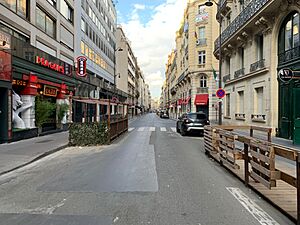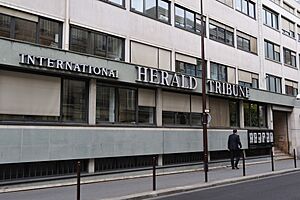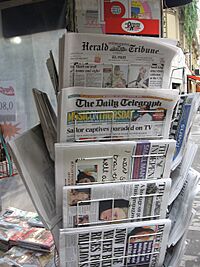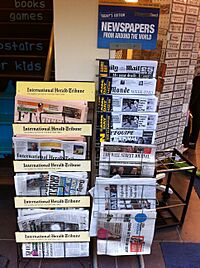International Herald Tribune facts for kids

The August 26, 2013 front page of
the International Herald Tribune |
|
| Type | Daily newspaper |
|---|---|
| Format | Broadsheet |
| Owner(s) | Whitney Communications, The Washington Post and The New York Times Company |
| Founder(s) | James Gordon Bennett Jr. |
| Founded | 1887 |
| Language | English |
| Ceased publication | October 14, 2013 |
| City | Paris |
| Country | France |
| Sister newspapers | The New York Times (1967–2013) The Washington Post (1967–2003) |
| ISSN | 0294-8052 |
The International Herald Tribune (IHT) was a daily newspaper printed in English. It was published in Paris, France, for people around the world who spoke English. Its big goal was to become "the world's first global newspaper," and it really did achieve that!
The newspaper started using the name International Herald Tribune in 1967. However, its history as an international paper goes all the way back to 1887. The IHT was sold in over 160 countries. It was a very creative newspaper that kept sharing new and interesting stories until it closed in 2013.
Contents
How the IHT Began
In 1887, a man named James Gordon Bennett Jr. started a Paris version of his newspaper, the New York Herald. He called this new paper the Paris Herald. Its first office was at 49, avenue de l'Opéra in Paris.
Later, in 1924, the paper was sold to the family who owned the New-York Tribune. This led to a new newspaper called the New York Herald Tribune. The Paris version became the Paris Herald Tribune. By 1967, the paper was owned by three different companies: Whitney Communications, The Washington Post, and The New York Times. At this point, it officially became the International Herald Tribune, or IHT.
The International Herald Tribune Years
The very first issue of the International Herald Tribune came out on May 22, 1967. It kept doing things that Americans living or traveling abroad loved. For example, it printed baseball scores and stock prices.
Early Offices in Paris
At first, the IHT used the same offices its earlier version had since 1931. These were at 21 Rue de Berri, close to the famous Champs-Élysées. A writer named Art Buchwald remembered these offices as old but "the perfect location" for an American newspaper overseas. In 1978, the newspaper moved its main offices to Neuilly-sur-Seine, a suburb of Paris.
Printing Around the World
In 1974, the IHT was a leader in using new technology. It started sending newspaper pages electronically across borders. This happened when it opened a printing center in London. Then, in 1977, another printing site opened in Zurich.
A big step happened in 1980. The International Herald Tribune began sending electronic images of its pages from Paris to Hong Kong using satellites. This meant the newspaper could be available at the same time on opposite sides of the world! This was the first time an English-language daily newspaper did this. By 1985, the IHT was printing 160,000 copies each day.
More printing locations were added, including Rome and Tokyo in 1987, and Frankfurt in 1989. By 1987, the IHT was opening a new printing site almost every year.
Global Reach and Content
By the early 1990s, the newspaper was printed at the same time all over the world. It had seven sites in Europe, three in Asia, and one in America. This allowed the paper to be available on the same day it was published in major cities everywhere.
What was special was that every region received the exact same news stories and even most of the advertisements. This was different from other international papers that changed their content for different areas. Nearly 200,000 copies were sold daily. About 50,000 were sold in Asia, and 45,000 went to airlines for international flights. Even with all this technology, stories often appeared in the IHT a day after they were in its parent papers.
Over time, most of the IHT's readers were no longer just Americans living or traveling abroad. The main editorial team for the International Herald Tribune was in Paris. While much of its content came from its parent papers, it also had its own reporters and writers. All the final editing was done by the staff in Paris. By 2002, the IHT had about 335 employees. Some writers, like Art Buchwald, continued to have their columns in the IHT even after they stopped writing for the parent newspapers.
Facing New Challenges
Over the years, the International Herald Tribune faced more competition. Other international newspapers like The Wall Street Journal, USA Today, and the Financial Times were also sold at newsstands. Also, new ways to get news appeared, like the global TV channel CNN and later the Internet. These made it easier for people to get sports scores and other news quickly.
As the 2000s began, people had different ideas about the IHT's future. Some thought it was old-fashioned, while others believed it still had an important role to play.
In October 2002, The New York Times announced it would buy out The Washington Post's share in the IHT. This made The New York Times the only owner of the International Herald Tribune. This change happened on January 2, 2003. The main office stayed in Neuilly-sur-Seine. In 2009, The New York Times combined the International Herald Tribune website with its own website.
In 2005, the paper opened its Asia newsroom in Hong Kong. In 2001, the Japanese newspaper The Asahi Shimbun worked with the IHT to publish an English-language newspaper called the International Herald Tribune/Asahi Shimbun. This paper continued even after The Washington Post sold its share, but it stopped being published in February 2011.
By 2008, the IHT printed over 240,000 copies each day. In the early 2010s, the online version of the paper had about seven million visitors every month. Overall, the IHT was one of the biggest global news organizations.
Famous Writers and Journalists
Throughout its history, the International Herald Tribune had many talented writers and journalists working from its Paris office. Some of the most well-known included:
- Art Buchwald, a humorist
- Suzy Menkes, a fashion editor
- Mike Zwerin, a jazz critic
- Waverly Root and Patricia Wells, who wrote about food
Some of its former executive editors were John Vinocur, David Ignatius, and Michael Getler.
The Final Years
In 2013, The New York Times Company announced that the International Herald Tribune would change its name to The International New York Times.
On October 14, 2013, the International Herald Tribune was sold at newsstands for the very last time. It stopped publishing under that name.
In 2016, the Paris offices of the newspaper closed. Many employees lost their jobs. One review called this the "end of a romantic era in international journalism."
Archives
All the articles from the International Herald Tribune, from 1887 until 2013, were sold or licensed to a company called Gale. They started making these articles available in 2017.
These old articles are not available from The New York Times archives. However, The New York Times website does have a small collection of "retrospective" stories from 1887–2013. This collection also became available in 2017.






